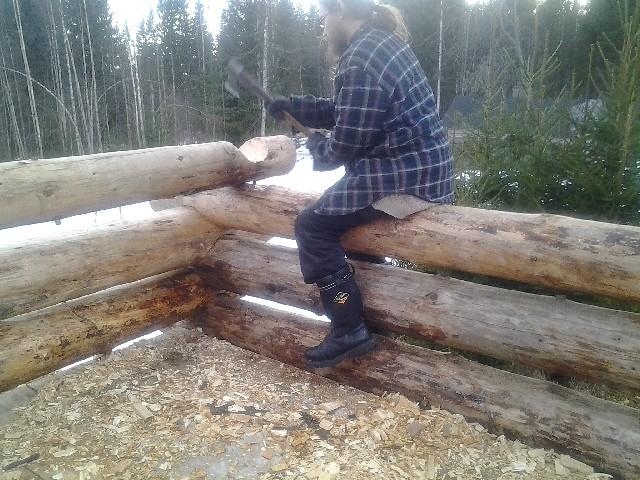
Simple log building
Last year in mid-November I did the groundwork for a firewood shed. And thought that I will slowly keep on building through the winter, and hopefully getting the shelter completed before the next spring. Those who have been following the Picture of the Day -series know that I've been slowly working with the project when time allows.
Today I got to the point where it is three logs above the floor level. So maybe it is time to write a blog post about the project. What I am building is probably the most simple kind of log building. The whole construction is held together by the corners - the belly side of upper log carved to fit the back side of the lower log. I've been using two axes - a carving axe with a longish blade, and then a small hand-axe for finishing. After I get the initial shape of the cleft done, I smear coal on the back side of the lower log. Then, fitting the upper log and turning it around again, I see where there are marks of soot, so I see where I need to carve more.
For a firewood shed it is okay to leave a small space in between each log. That way the wind can go through the walls, which helps the firewood to dry further. The usual cycle is that trees are cut down in January / February, chopped to firewood in March / April, left outdoors in a heap so that sun and wind make them dry, and then stored inside a shed in June. Summer air tends to be bit more moist, and there is rain like every third day, so it is better to have firewood under a roof. Oh well - this is how it has been. I don't know how much it will change, if the winters keep on getting milder and milder. Sub-freezing air has a very low humidity - but lately we have had winters with extended periods of temperatures fluctuating around -5 .. +5°C, with a lot of rainfall. Which makes the winter air damp. If there won't be no more a long dry period of winter, all the wooden buildings are more prone to rot and mold. And it will be harder to make the firewood properly dry. We will see how it goes, the coming decades...
The logs I'm using are from storm-felled trees. Which means that I didn't get to choose the trees; some of them were rather thick. So I'm placing the thickest (and heaviest) logs on lower layers, and the higher the wall will get, the thinner logs I'll be using. That will make easier to lift the lighter logs up the wall once it will get to shoulder-level and higher. Also, I wish Sami will have time to visit at some point - as the wall will get higher, it will be far more easier to work together with another person. And, anyhow, I'll be posting more at the later stages of the project. For now it is rather simple, just carving the corners, log after log getting the walls up.
Generally speaking, when building a heated room, one would want to make the walls tight. That would mean carving the corner clefts deeper, and then for the whole length of the log carve the belly side so that it will fit the back side of the lower log. I mean, there'd be a smaller cleft running lengthwise the bottom side of the log. Dry moss or flax has been used in between the logs to make it properly air-tight. I've never tried that, but I'd like to learn it some time.


Add new comment